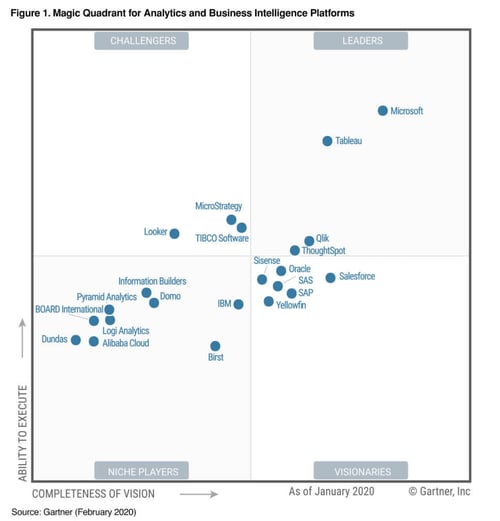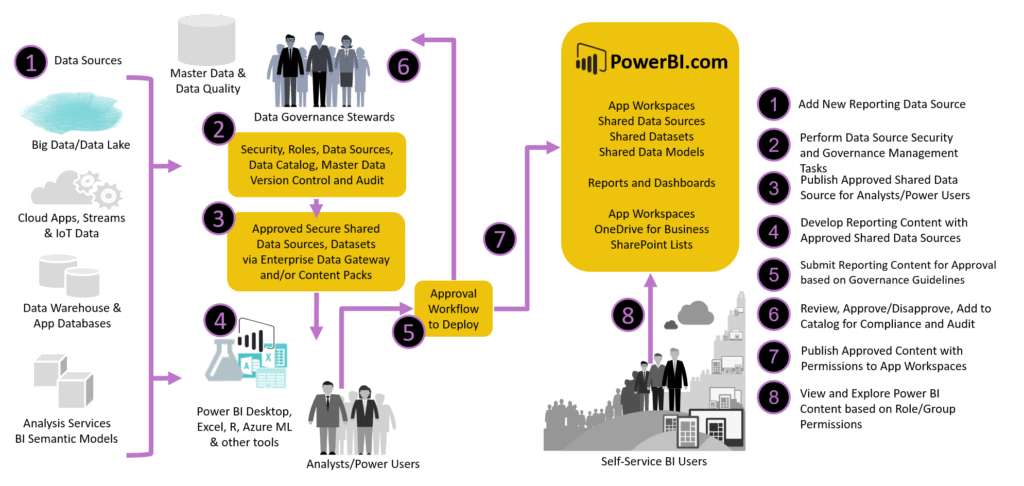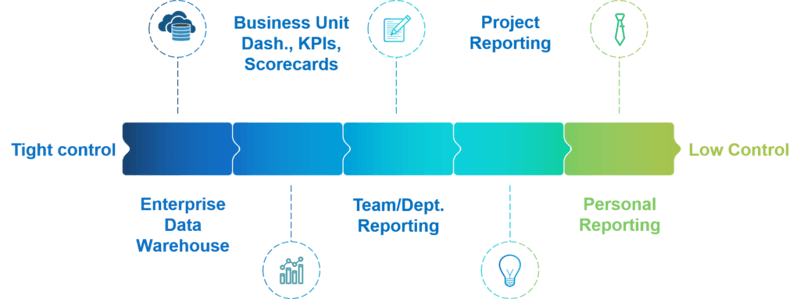Organisations generate and collect data each minute. The goal of enabling self-service analytics is to help executives make better decisions, take smarter actions, and operate more efficiently, closely guarded by a proper governance process.
The key focus areas of data governance include availability, usability, consistency, data integrity, and data security thus ensuring effective data management throughout the organisation.
We’ve tailored this article on Power BI as a representative self-service analytics platform that ensures high quality across the complete lifecycle of data by establishing processes that provide effective data management and accountability across the organisation.
Through Power BI, Microsoft has been an analytics and BI leader for the past 13 consecutive years, as illustrated in the below Gartner Magic Quadrant.

The importance of governance in self-service analytics
Data quality has increasingly moved to the epicentre of many analytics trends, including self-service analytics and it is a key goal for organisations in 2020.
Additionally, customer experience is increasingly digitally-driven and demanding, requiring more and more insight to deliver personalized experiences and services. To achieve this, information derived from data must be acquired quickly and organisations can employ self-service BI tactics to accommodate the increased need for information and data on demand.
Rita Sallam, research vice president at Gartner, noted that “Data preparation is one of the most difficult and time-consuming challenges facing business users of BI and data discovery tools, as well as advanced analytics platforms. Thus, right now Data Preparation and Data Governance tools must be designed within the Self-Service BI platforms if organisations want the agility of Self-Service BI and Data Discovery without compromising Data Quality”.
The impact of data governance on self-service analytics
Data governance is nowadays more of a must-have rather than a nice to have. Whether organisations are seeking regulatory compliance, fraud prevention, security, and privacy breaches, they have to insist that BI tools must be able to handle their data preparation and provide at least a minimal amount of governance.
This can be a challenging aspect, as with personal self-service BI tactics, the content is created primarily for personal use without any collaboration or sharing and the content author has a lot of flexibility.
An example in which additional data and governance policies may become applicable is when a Power BI user is using a self-service BI platform for personal data analysis and then they may proceed to share his solutions with colleagues.
As a plan ahead for self-service BI success, you should avoid the uncontrolled proliferation of unsupported Business Intelligence applications and implement processes for auditing, data classification, and data governance.
Since both business and IT are involved, a proper governance process not only increases user adoption and drives infrastructure and technology decisions, but also it reduces risks.
A potential end-to-end governance process

Source: Microsoft.com
Areas and actions for consideration
- Sensitive data is uploaded to the service
- Shared content
- Publishing data to the entire organization
- Publishing data to be available externally/share data with 3rd parties
- Audit logs
- Duplication of effort, data, and resources utilization
- Confusion and misinformation
- Oversimplifying complex topics (e.g. ALM, cloud/on-prem connectivity, security)
Mitigation path
- Setting in place security standards for accessing source data, and business information in reports, Power BI Desktop and Excel
- com app workspaces or Power BI Report Server folders
- Control the published source data and business data models
- Make use of existing investments such as the data warehouse (DWH)
- Use data endorsement labelling (None, Certified, Promoted)
- Set up best practices and governance, and involve IT

What to track in a Power BI governance program
Usage
Including user access frequency, as well as popular datasets, models, and reports. Also includes auditing of publishing actions. This information can be used for security and compliance, identification of support needs, identification of critical reports, and/or potential ownership transfer opportunities.
Security
Report sharing activities and row-level security defined in the Power BI model, as well as ownership of datasets, reports, and dashboards. This information is important for the validation of security and compliance. There are three main approaches to sharing with others: (1) sharing a read-only dashboard from a workspace, (2) including a colleague as a member of an app workspace, and (3) including a colleague as a recipient of a published app.
Performance
A critical feature to enable adoption is reported rendering speed, which needs to be put into the balance with the level of accuracy vs. perceived value to the users.
Data sources
Including data sources utilized, data refresh operations, data model sizes, as well as calculations. This information can be used to identify potential flaws
in data integrity or even overlap in the effort. It is also important to monitor the growth of models that have data imported, given the size limitations of various Power BI licensing options.
How can Encora help you?
At Encora, our expertise covers the most important Business Intelligence and Analytics platforms like Tableau, Power BI, and Qlik, so we can help you make the optimal decision to invest in a self-service analytics solution that can offer you a proper governance process that best suits your organisation.
We invite you to have a look at our side-by-side comparison of Microsoft Power BI and Tableau to meet the self-service analytics needs and what you need to keep in mind when you are choosing the self-service analytics platform for your organisation, in one of our previous blog articles that you can find here.
Resources:
- https://docs.microsoft.com/en-us/power-bi/admin/service-admin-governance
- https://searchdatamanagement.techtarget.com/feature/How-to-improve-data-governance-for-self-service-analytics
- https://www.gartner.com/en
- https://www.infogix.com



